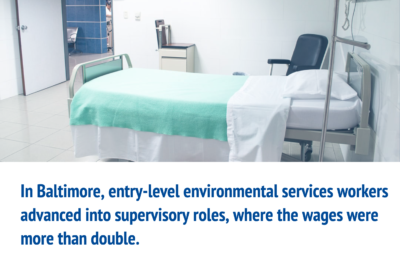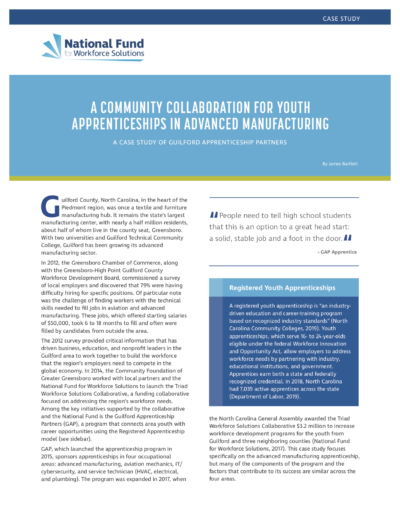Two new case studies of apprenticeship programs highlight different approaches to this tried and true workforce model
 With unemployment remaining at record lows, employers are coming up with creative ways to bring in talent. However, the best solution could be one of the oldest: apprenticeship. Employers can build a pipeline of workers who gain the skills and knowledge they need to succeed on the job through apprenticeship. The National Fund recently released two case studies profiling different journeys to establishing apprenticeship programs for in-demand jobs: the Baltimore Alliance for Careers in Healthcare (BACH) in Baltimore, Maryland, and the Guilford Apprenticeship Partners (GAP) Greensboro, North Carolina. These case studies demonstrate why apprenticeship can be a win-win for employers and workers alike.
With unemployment remaining at record lows, employers are coming up with creative ways to bring in talent. However, the best solution could be one of the oldest: apprenticeship. Employers can build a pipeline of workers who gain the skills and knowledge they need to succeed on the job through apprenticeship. The National Fund recently released two case studies profiling different journeys to establishing apprenticeship programs for in-demand jobs: the Baltimore Alliance for Careers in Healthcare (BACH) in Baltimore, Maryland, and the Guilford Apprenticeship Partners (GAP) Greensboro, North Carolina. These case studies demonstrate why apprenticeship can be a win-win for employers and workers alike.
Apprenticeship must be employer-driven. Without engaged employers investing in their workforce, apprenticeship simply could not happen. In Greensboro, the creation of the apprenticeship partnership was driven by local employers who needed to fill critical advanced manufacturing positions. In Baltimore, employer partners helped design an environmental services manager apprenticeship program to best meet their needs. “Greensboro’s model is a more traditional time-based apprenticeship and the Baltimore model is competency-based. Even though they were designed and structured differently, employers and workers in both cities met their goals; employers cultivated talent and young adults secured great jobs,” said Kelly Aiken, vice president at the National Fund. “It just goes to show the versatility of apprenticeship as a workforce solution.” While some workers and students may be wary of apprenticeship, it has real benefits for them. In Baltimore, entry-level environmental services workers advanced into supervisory roles, where the wages were more than double. With its education component and progressive wage scale, apprenticeship provides good jobs for workers, while providing employers a competitive advantage in a tight labor market.
But apprenticeships cannot be built by employers alone. The support of the whole community is needed for apprenticeship to succeed. Education, government, and workforce systems must work together to build successful apprenticeship programs. Co-investment from philanthropy can accelerate these programs, like the investments that jumpstarted the program in Greensboro. Additionally, working together can help break down barriers and make systemic change to expand apprenticeship programs. The Baltimore partnership was able to successfully lobby the state of Maryland to change requirements for registered apprenticeship programs, resulting in a transportable program that can meet the unique needs of each employer. Apprenticeship can also break down social barriers as well. The program in Greensboro has been working on breaking down barriers to bring more workers of color into their apprenticeship program, while the Baltimore program was able to expand more opportunities to immigrants.
The work highlighted in these case studies is echoed throughout the National Fund network. In the Mobile region, for example, the Southwest Alabama Workforce Development Council has a new and growing hospitality apprenticeship program. Their program, like the two in the case studies, is employer-driven to meet local industry needs, relies on community buy-in and support, and meets employers’ demand for skilled workers while equipping workers with the skills and knowledge needed to succeed.
“We’re in the game of getting our local people who need opportunity into this industry where there’s family-sustaining wages. There was such a need that we have 18 separate businesses, many with multiple venues, to sign on to our program. We have about 30 apprentices in the program now, and we think we’ll have 100 by the summer.” – Josh Duplantis, Executive Director, Southwest Alabama Workforce Development Council
These case studies really highlight why apprenticeship is the “Cadillac of workforce development.”
Read the Case Studies





